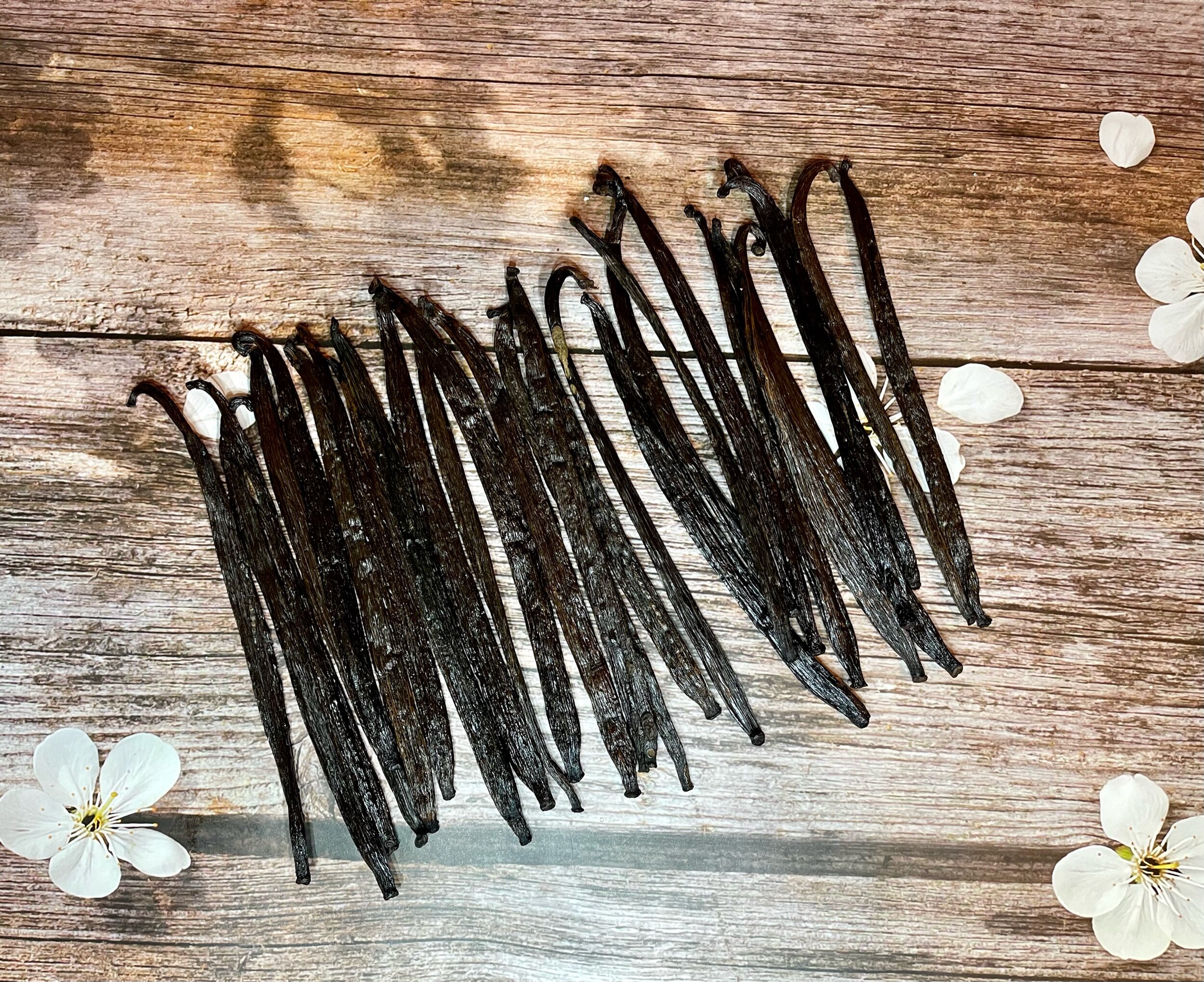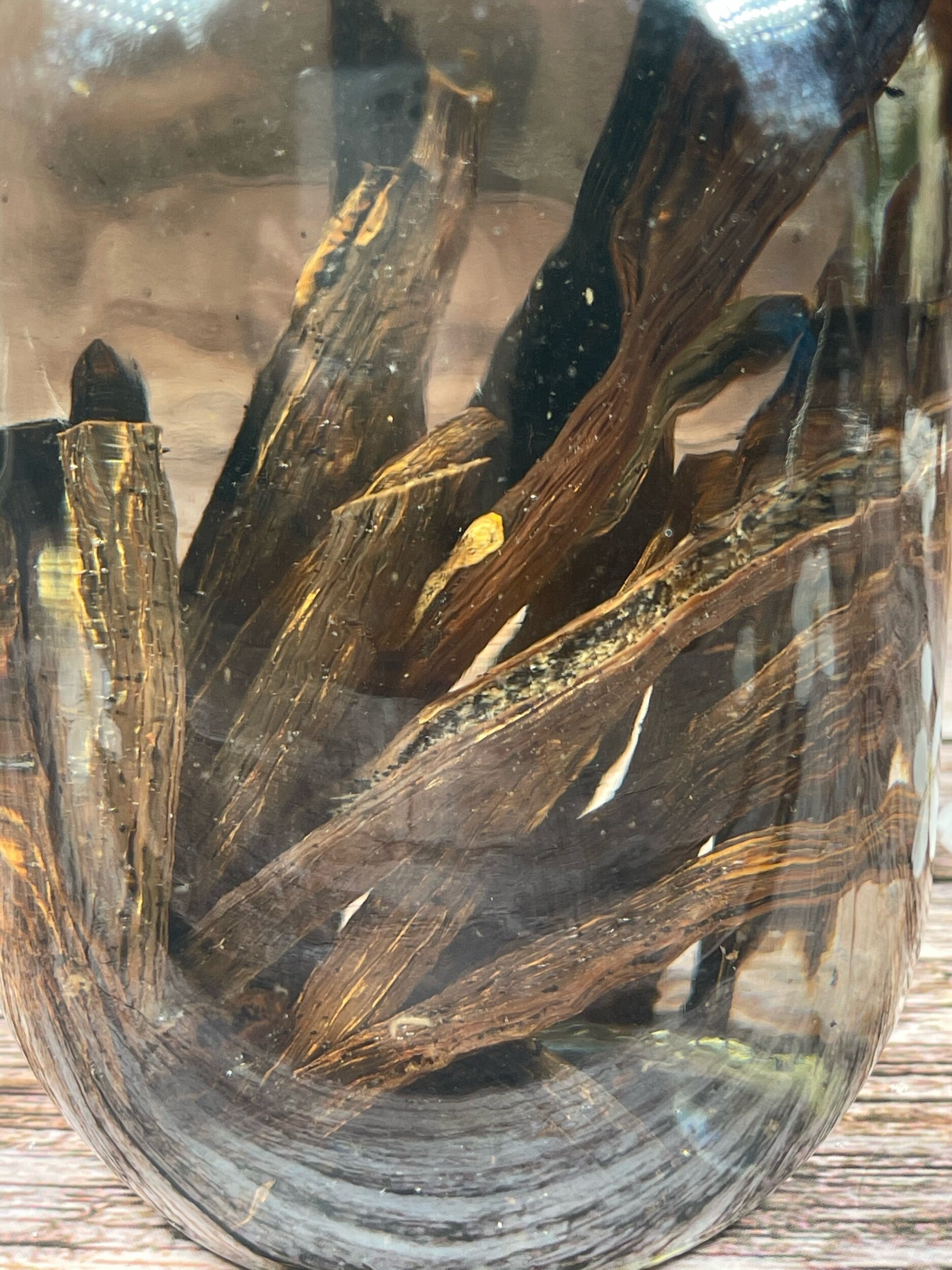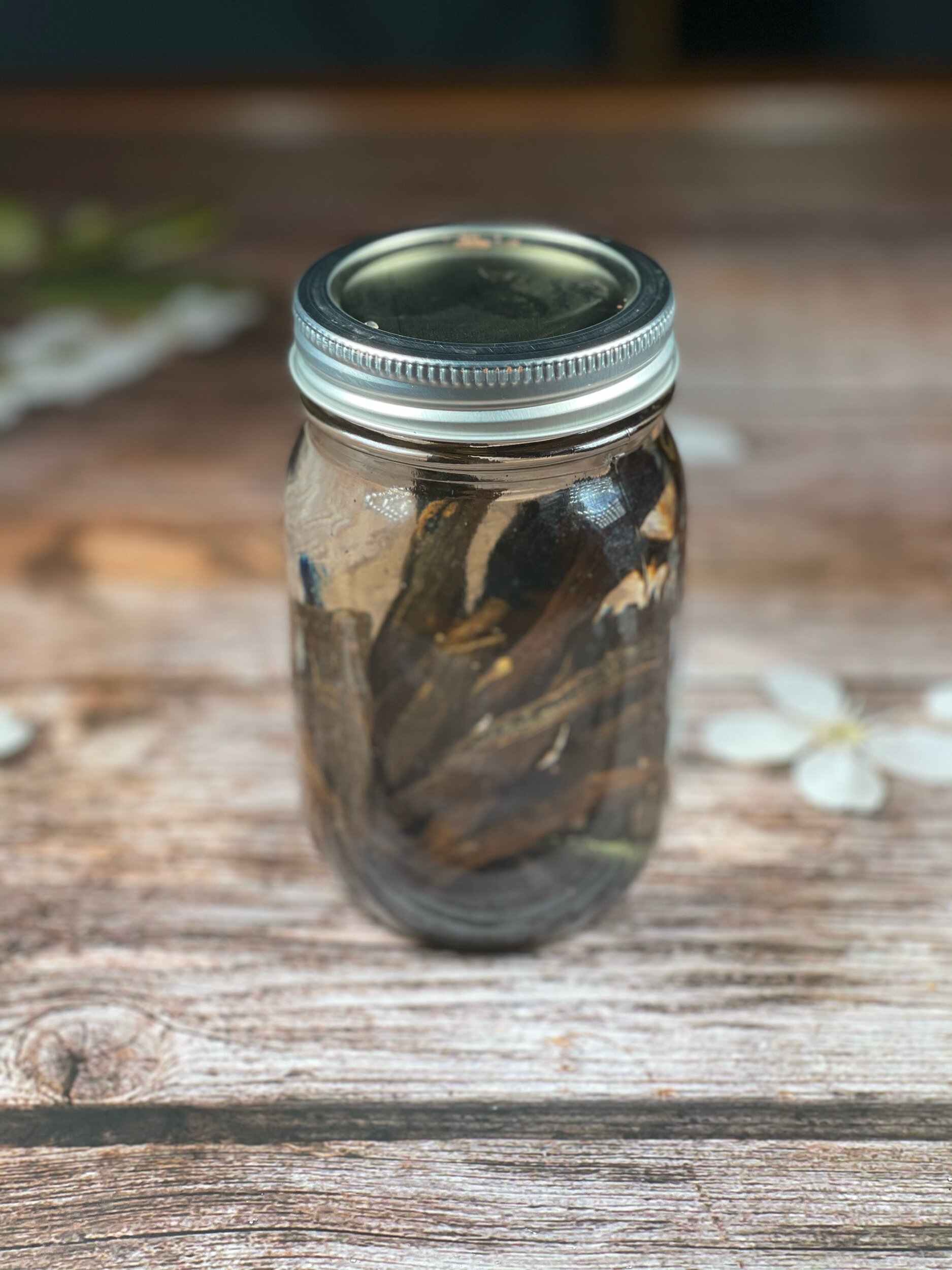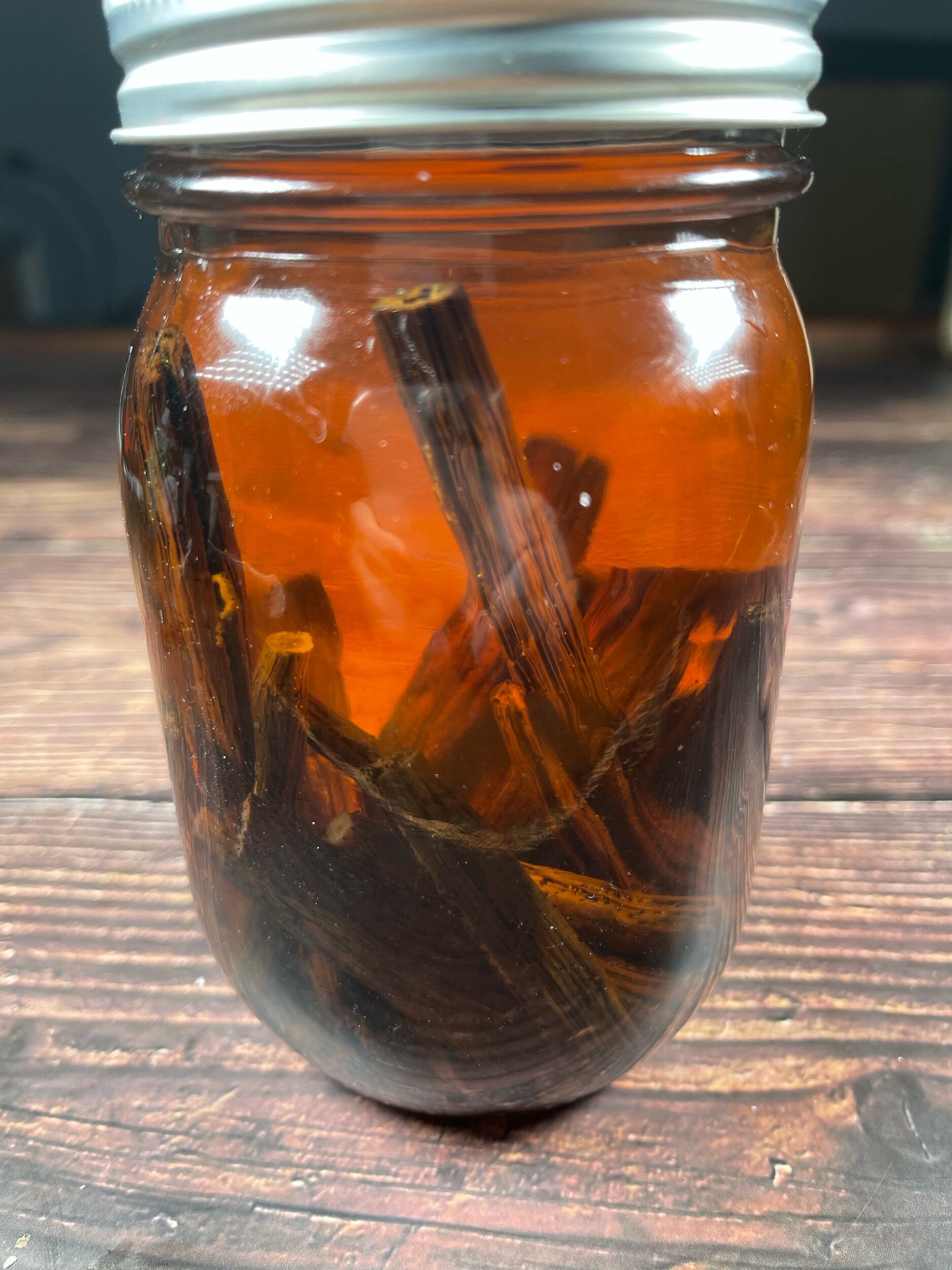Vanilla Extract
Updated: July, 13, 2022
Ah, Vanilla extract….One of the simplest homemade culinary substances around. You would think it would be without controversy, but alas, you would be incorrect. Some of the questions that swirl around within the vanilla community (no, I am not kidding) are: Which vanilla bean should I use? Does the species matter? Why is there Bourbon in Madagascar Vanilla? (let’s nip that in the bud, there is none), How many beans do I use to make extract? Grade A or B? What brand of alcohol do I use? These are just the most common that I see out there, adding a touch of anxiety to making the extract and it doesn’t have to be that way. The bottom line? Don’t over think it. Whilst as you learn more of the options you may find which types of vanilla beans or alcohol you prefer, starting with a good basic recipe is all you need to enjoy homemade vanilla extract.
I am going to do things a bit backward and start off with the recipe and have the other info detailed below, except to explain what a “fold” is. “Fold” is synonymous with “strength”. When you buy vanilla extract in the grocery store it is a single “fold” product. Think of it as “regular strength.” The requirements for the FDA in the US is that vanilla solids need to equal 13.35 ounces per gallon of extract and that the moisture content of those pods can not exceed 25%. However, you can also buy vanilla extract in double and triple fold ratios which is double and triple the strength. Do professional chefs use higher folds? Not usually. Respectfully, it’s reserved for Vanilla Homemaker groups who for some reason think they found something special when in reality it is just compensating for subtleties of home extracting. I am going to detail the recipes for each, just in case, BUT…. if you are not familiar with using higher strength vanillas, stick with regular old single fold as it is what the vast majority of recipes are based on. Is your head reeling yet? Don’t worry, just follow the exact recipe card below….
A Few tips to keep in mind…
The more surface area you give the pods the better, ie: cutting them up
Providing agitation also assists the process, ie: shake the jar every few days
Temperature helps, but don’t go bananas! You do not want to heat the vanilla and ruin volatile compounds which provide the more subtle flavor notes, but putting it in a toasting corner and ensuring it stays under 100 degrees F will give it a nice boost towards the finish line.
The seeds themselves, while pretty in a recipe, a flavorless. They only have a “flavor” because of any vanillin attached to them. Once they have been soaking in alcohol or any medium that vanillin detaches from the seeds, they no longer hold any flavor value.
Recipe Card
Vanilla Extract- Single Fold
Ingredients
Method
- Take the vanilla pods and clip off the very tips of each side.
- Run a knife down one side of the pod to expose some of the vanilla seeds.*
- Place the pods into a glass container that has an airtight seal. Using an amber or other colored bottle while not mandatory, can help with blocking out the light to the extract.
- Pour the alcohol into the container. If the alcohol does not cover all of the pods completely, either fold the pods or cut them into smaller pieces so they are fully submerged.
- Store the sealed jar for 6-8 weeks in a dry, dark location. under 75 degrees F.
- Once a week, check to make sure the pods are still fully submerged and give the bottle a quick shake.
- Starting at 6 weeks you can smell and taste the extract to see if it's to your liking. If not, continue to let it sit.*
* Notes (if you see an * please check here):
- Yes you can round up to 1 ounce of beans to 8 ounces of alcohol
- For beginners, I suggest using Vodka.
- Why don't we use bean counts? Because vanilla pods/beans vary greatly in size! Depending on where they are sourced they can be anywhere from 4 inches up to 12 inches long.
- You do not have to slice the pods open nor clip the ends off if you don't wish to. It just allows the process to go a bit faster.
- Do not toss the tips if you clip them. You can make vanilla sugar by tossing them with a cup of sugar and letting it sit to perfume the sugar.
- Whilst it is not at all necessary, some folks let the extract sit for 6 months to a year and beyond before using it. That is personal preference but realize the stronger it gets you may have to alter how you use it in recipes.
Vanilla Extract- Double Fold
Ingredients
Method
- Take the vanilla pods and clip off the very tips of each side.
- Run a knife down one side of the pod to expose some of the vanilla seeds.*
- Place the pods into a glass container that has an airtight seal. Using an amber or other colored bottle while not mandatory, can help with blocking out the light to the extract.
- Pour the alcohol into the container. If the alcohol does not cover all of the pods completely, either fold the pods or cut them into smaller pieces so they are fully submerged.
- Store the sealed jar for 6-8 weeks in a dry, dark location. under 75 degrees F.
- Once a week, check to make sure the pods are still fully submerged and give the bottle a quick shake.
- Starting at 6 weeks you can smell and taste the extract to see if it's to your liking. If not, continue to let it sit.*
* Notes (if you see an * please check here):
- Yes you can round up to 1 ounce of beans to 8 ounces of alcohol
- For beginners, I suggest using Vodka.
- Why don't we use bean counts? Because vanilla pods/beans vary greatly in size! Depending on where they are sourced they can be anywhere from 4 inches up to 12 inches long.
- You do not have to slice the pods open nor clip the ends off if you don't wish to. It just allows the process to go a bit faster.
- Do not toss the tips if you clip them. You can make vanilla sugar by tossing them with a cup of sugar and letting it sit to perfume the sugar.
- Whilst it is not at all necessary, some folks let the extract sit for 6 months to a year and beyond before using it. That is personal preference but realize the stronger it gets you may have to alter how you use it in recipes.
Back to some background….
Vanilla is the fruit product from vanilla bean orchids which are a vining orchid that require high temperatures and humidity to grow. Choosing which vanilla bean to use can be overwhelming once you explore the options available, however there are three main species of vanilla pods that are edible. They are Vanilla Planifora, Vanilla Tahitensis and Vanilla Pompona. Each species has unique flavor profiles which are further changed by the area they are grown due to their climate and the soil they are grown in, as well as the method used to dry and cure the pods. Below is some basic information about the various species as well as a bunch of common varieties. It is not all inclusive as many other places cultivate vanilla on different scales, each having a unique aroma profile.
Vanilla Species Characteristics
Vanilla Planifora
Vanilla Planifora is the original vanilla from which all other vanillas derive. It was originally cultivated in what is now called Mexico but then brought elsewhere around the world. It is the most common vanilla you’ll find in the food industry. Its flavor notes vary depending on where it is grown. Planifora only blossom for one day when they are hand-pollinated into order to produce the vanilla pods we know and love.
Vanilla Tahitensis
Vanilla Tahitensis is a very close cousin of Planifolia and grown primarily on the island of Tahiti, its namesake, where cultivation initially began. Tahitensis is used in extract but it is known for its use in the fragrance industry due to its light floral notes from it’s high levels of heliotropin. It is the result of a natural hybridization between Vanilla Planifolia and Vanilla Odorata, which occurred in Maya cacao forests. Tahitensis has the least amount of vanillin content.
Vanilla Pompona
Vanilla Pompona is the hardest to find as its the only one of the three that needs to be naturally pollinated by bees. It is primarily found in Peru, but also in the Caribbean and Mexico, and is prized for their high vanillin content. It is described as lightly floral, fruity, but also a touch of spiciness. From research there is some conflicting information suggesting that V. pompona was the original vanilla available and was supplanted by the V. planifora as it did better on plantations.
Vanilla Grades
Vanilla Grading is about appearance and moisture level, not about quality. Which grade you use is dependent on what you wish to do with them. In general, Grade A is use for cooking/baking and Grade B for Extracting.
Grade A, aka Gourmet Grade:
Grade A vanilla beans are also referred to as premium or gourmet grade beans because of their moisture content and versatility in recipes. They have a moisture content of 25-35% and are dark brown and very pliable. Some growers split the grade into Grade A-1 (30-35% moisture) and A-2 (25-30% moisture). Due to the moisture content, they are not as flavorful as Grade B beans, but they infuse quickly into dishes. While they can be used for extract, more area is needed to compensate for the higher moisture which is why grade B is preferred, saving the gourmet beans for delicious desserts and other dishes. The vanilla seeds inside the pods are also prized to be used in various recipes to impart the beautiful vanilla flavor.
*If you are using Grade A beans for extract, the standard would be .91 ounces of beans per 8 ounces of alcohol.
Grade B, aka Extract Grade:
Grade B beans are also referred to as “Extract Grade” beans because the flavor is more concentrated due to their lower moisture content of 15-25%. They tend to have a reddish brown color and are skinnier and noticeably drier than Grade A beans. While they take a little longer to give up their flavors into the extract, you will be rewarded with the richness they provide. If the bean isn’t overly dry, the seeds inside can still be used for desserts to impart their flavor.
Types of Vanilla Beans
Madagascar aka “Bourbon” Vanilla
Ok, so “Bourbon” has nothing to do with whiskey. It is so named because where it is grown used to be referred to as the Bourbon region of Madagascar, Île Bourbon. Many times V. planifora is used synonymous with Bourbon since most were cultivated in that region. However, Bourbon beans can now be found elsewhere. The Madagascar variety is described as “rich and creamy” as well as “woody.” Madagascar is the leading cultivator of Vanilla in the world.
Mexican Vanilla
Mexican vanilla is also from the V. planifora species but due to its climate and curing and drying process, produces an incredible vanilla that is prized and arguably called “the best vanilla in the world” and it’s also usually the most expensive. Mexican vanilla is smoother and mellower than the Madagascar variety and has a spicy, smokey/woody fragrance that gives it more depth. This fragrance is because of the curing process where in Mexico they lay the beans out in the hot sun to “kill” the pods so they stop growing. This process is a bit harsher but it gives the smokey/woody scents that make it wonderful to work with. One thing to be aware of is some companies grow beans in Madagascar and then cure them in Mexico and try to pass them off of “Mexican Vanilla.” This is not Mexican Vanilla as it needs to be both grown and cured in Mexico to have the distinctive and sought after qualities.
Indonesian Vanilla
Indonesian beans are from the V, planifora species and very similar to the Madagascar variety. Most would not notice the differences between the two but it has flavor notes that have been described as cinnamon and buttery and most of all, smokey. Indonesian beans have a unique curing/drying process which gives a smokier flavor to the pods. Also due to the extended sunning process for drying the beans, it makes the beans tolerant to higher temperatures than other varieties, making them loved by chefs infusing their flavor into desserts. Indonesia is the second largest cultivator of vanilla beans in the world.
Peruvian Vanilla
Peruvian Vanilla is from the V. pompona species and is known for its large fat pods. They are described as having a smoky sweet aroma with raisin and floral notes. There is a movement to increase production as well as its exposure to help the local Peruvian economies. If you wish to learn more about it, you can visit The Pompona Project website or the Vanilla Pompona website.
Papua New Guinea Vanilla
Papua New Guinea is known for growing two species of vanilla, each with subtle notes from their primary cultivator. Both varieties are frequently available in various online vanilla co-ops where folks can pool money with others and bulk buy vanilla pods.
Their V. tahitensis species is similar to its namesake in Tahiti, but it boasts a brighter and even more floral aroma.
Their V planifora species is very similar to the Madagascar variety but with added notes of figs and raisin.
Tahitian Vanilla
Tahitian vanilla is of course V. tahitensis species. The pods are bursting with seeds and the flavor is delicate and sweet. The aroma has been described as floral, with undertones of caramel, cherry-chocolate, licorice, peach and red wine. While they are used primarily in the fragrance industry, they are also prized by chefs to make great extract as well as using the subtle flavor in sweet desserts.
Tongan Vanilla
Tongan Vanilla are also a V. planifora variety and very hard to come by as only 144 tons of vanilla is cultivated annually. A little over 10 years ago, all the vanilla plantations were dormant until a renewed interest and efforts, 95% of those plantations are now back to producing. The Kingdom of Tonga is known for their rich fertile soil, creating rich and bold vanilla flavor. It is sought after to pair with chocolate due to its unique and very pronounced flavor profile. That flavor profile has been described as “strong, full, rich; red wine; aroma of raisins.”
Ugandan Vanilla
Ugandan beans are also from the V planifora species but soil and climate of Uganda create a bolder and earthier vanilla bean taste than the Madagascar beans. It has been described as having hints of figs and raisins, and is prized for its higher-than-average vanillin content. This makes them perfect for vanilla extracts plus strong desserts that need that bolder vanilla to shine through.
Where do I get Vanilla Beans?
Well, first off, you can usually find them in the spice aisle at the grocery store but you’ll be surprised at the cost. Vanilla Beans are the second most expensive spice, behind saffron. They became even more expensive in 2016 when below average crop yields in the two large cultivating countries, Madagascar and Indonesia, coincided with the demand for “clean labels” and natural products. Prices further got impacted after 30% of vanilla crops were wiped out in Madagascar in 2017 when the area was hit by a cyclone. Finally 3 years later, prices came back down a bit as the high prices no longer were sustainable and crops rebounded. With that being said, they still are really pricey and buying 2 beans in the grocery store for $25.99 is pure madness. Seriously, that is the current price at my local Stop and Shop for 2 McCormick brand Madagascar Vanilla Beans! That brings us to the internet. There are many vanilla companies on line that you can google and try, as well as the trusty standby, Amazon, where you with find fairly reasonable beans for sale. The last option are co-ops. If you search “Vanilla Bean Co-op”, a popular one will pop up, plus there is a rather large one on Facebook by way of a group that you can join. The co-op option has positives and negatives. Positive being the price as well as finding some unique beans from around the world. The negative being that you need to pre-order them and then wait 6-8 weeks to receive them many times. Also, co-ops have their own grading system which can get pretty confusing. While there is in deed an industry standard to grade pod by moisture content and then appearance (for blemishes), there is no legal definition. See, I told you there was controversy!
So, there you have it. More than you ever cared to know about Vanilla Beans at your finger tips. Where you you start? Grab some alcohol, add some beans and test the outcome. Then you can experiment from there! Enjoy!



